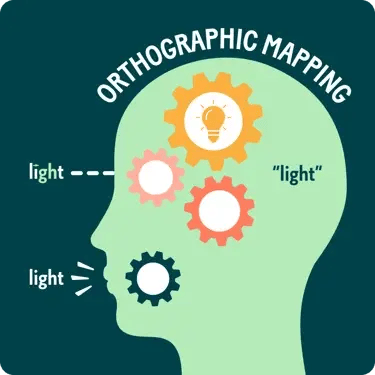The Power of Orthographic Mapping
Reading fluency is more than just recognizing words on a page; it’s about effortlessly retrieving them from memory. This ability stems from a process known as orthographic mapping - a cognitive mechanism that allows readers to store words in their mental lexicon for instant recognition.
What is Orthographic Mapping?
Orthographic mapping is the process by which written words become permanently stored in long-term memory. Each time a reader successfully decodes a new word - by sounding it out, saying it aloud, and recognizing its meaning - the brain begins to imprint its unique letter sequence. Over repeated exposures, this pattern becomes solidified, allowing for rapid and effortless word retrieval (Ehri, 2015).
Dr. David Kilpatrick (2015) describes orthographic mapping as “the mental process we use to permanently store words for immediate, effortless retrieval.” This process enables readers to transition from decoding unfamiliar words to recognizing them instantly. Unlike traditional “sight word” memorization, which relies on visual recognition of word shapes, orthographic mapping is rooted in the connection between letters and their corresponding sounds.

How Readable English Supports Orthographic Mapping
This is where Readable English comes into play. Readable English enhances decoding by making every English word phonetically transparent. The built-in pronunciation guide provides essential cues, allowing readers to correctly sound out, say, and hear words multiple times - key steps in embedding them into long-term memory.
This level of scaffolding is especially beneficial for English learners and students with reading difficulties. By reducing the complexity of word recognition, Readable English accelerates the process of orthographic mapping, making reading more accessible and fluent.
The Role of Orthographic Memory
Each successful decoding experience contributes to orthographic memory, the mental repository of familiar word patterns. Once a word has been orthographically mapped, it is stored as a unique letter string and can be read effortlessly. Research indicates that after just one to four exposures, a word becomes unitized - meaning it can be recognized instantly without needing to be decoded each time (Kilpatrick, 2015). This explains why experienced readers can distinguish similar-looking words like trap and tarp, diary and dairy or sleep and steep without confusion.
How Teachers Can Support Orthographic Mapping
While orthographic mapping is a natural cognitive process, it requires foundational skills to develop effectively. Teachers play a crucial role in fostering this process by:
-
Encouraging phonemic awareness - the ability to identify and manipulate sounds within words.
-
Reinforcing phonics instruction, ensuring students understand letter-sound relationships.
-
Providing multiple opportunities for decoding practice, allowing students to encounter words repeatedly.
-
Using Readable English to make decoding easier and more intuitive for struggling readers.
Orthographic mapping is the key to fluent reading, allowing readers to move beyond slow, effortful decoding to effortless word recognition. By supporting this process through phonics-based instruction and tools like Readable English, educators can empower students to become confident, independent readers.
When words are firmly embedded in long-term memory, reading becomes second nature - unlocking a world of knowledge and literacy for every learner.
Learn More
Explore the key areas that support effective reading instruction:
-
-
Phonics
-
Phonemic Awareness
-
Fluency
-
Vocabulary
-
Comprehension
-
.png?width=350&height=60&name=Readable%20English%20Logo%20(1).png)

